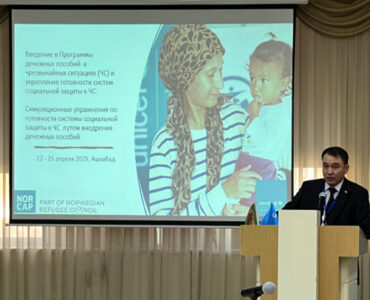The book “Climate Change in Central Asia: Decarbonization, Energy Transition, and Climate Policy” (2023) gives an overview of climate change research in Central Asia, focusing on the impact on the region and tensions over natural resources. It explores energy systems, decarbonization efforts, and energy transition in Central Asia. This article highlights key points from the book with a special emphasis on Turkmenistan. Research on climate change and decarbonization of the energy system in Turkmenistan is extremely limited, with only a few identified studies on the country out of over 300 studies conducted on Central Asia as a whole.
Climate change research in Central Asia
Climate change will bring about substantial transformations, including higher mean temperatures, extreme heat, and the disappearance of snow and glaciers in the crucial Pamir and Tien Shan Mountain ranges, which directly affect local communities. The likelihood of increased precipitation, floods, and landslides is also projected. Central Asia heavily relies on agriculture, a sector expected to face significant consequences from climate change. On one hand, elevated CO2 levels and warmer temperatures may enhance crop yields, but on the other hand, extreme weather events like droughts and floods can have devastating impacts.
Over the past 20 years, a rapid growth in research on climate change in Central Asia has been observed in the scientific literature. However, out of 325 publications identified, only 5 focus on Turkmenistan, revealing a significant research gap in this area. The situation is not much better in Russian language research, with only one study found on Turkmenistan, while other Central Asian countries receive more attention. Similarly, research on decarbonizing the energy systems in Central Asia has largely excluded Turkmenistan. Among 305 scientific articles published from 1991 to 2022, only 8 pertain to Turkmenistan, with keywords “natural gas” and “oil” being the most commonly used. Generally, a shift from fossil fuels to renewable energy sources has been observed in regional research during the examined period.
Climate change is gradually gaining attention in policy discussions across the region, driven by the growing visibility of extreme weather events and increasing social awareness. This mounting pressure is urging local governments to take action. All five Central Asian countries have committed to nationally determined contributions (NDCs) under the Paris Agreement. However, no substantial structural reforms have been implemented to fulfill these commitments.
Turkmenistan ranks third in Central Asia for its carbon footprint, responsible for emitting approximately 85 MtCO2-eq (12% of the region’s total) in 2019. From 1998 to 2014, per capita emissions in Turkmenistan rose by nearly 70%. The country exhibits the highest energy and carbon intensity per GDP among Central Asian nations. Turkmenistan heavily relies on fossil fuel consumption, and retail prices for electricity and gasoline are significantly subsidized, distorting the true cost of energy, and promoting excessive fossil fuel use. Consequently, the expansion of renewable energy sources is discouraged, despite the region’s abundant solar and wind potential and ample available land.
Currently, only Kazakhstan has implemented carbon pricing instruments, while other Central Asian countries are also exploring their potential adoption. Turkmenistan, for instance, is considering the implementation of emissions trading systems or green certificates, as outlined in the National Strategy on Climate Change (2019) and National Green Economy Concept (2020). The reduction of emissions is emphasized through energy efficiency, conservation, sustainable use of fossil fuels, and increased utilization of alternative energy sources. In 2017, the president signed a decree approving the State Energy Saving Programme for the period 2018-2024, which includes the establishment of a greenhouse gas inventory and a measurement, reporting, and verification system for inventory implementation.
Interests of petrostates vs. decarbonization
The book explores how Central Asian petrostates have embraced “green” identities by discussing decarbonization policies. However, they simultaneously seek collaboration with major fossil fuel producers (like Russia) for investments and with major consumers (like China) for sales. This approach serves to protect their interests, particularly the reliance on fossil fuel exports, while impeding the transition to renewable energy sources. The book suggests that Turkmenistan has likely become the most gas-dependent country globally, both in terms of exports and domestic energy systems. Despite this, the country strives to enhance its public image, evident in its membership in the International Renewable Energy Agency (IRENA) since 2018 and engagement in cooperation with the UNDP.
In the 26th Conference of the Parties in Glasgow in 2021, the five Central Asian republics presented a unified front under the slogan “5 countries, 1 region, 1 voice” and shared proposals. This unity is noteworthy considering the region’s historical and social tensions related to borders and water management. All five countries have ratified the Paris Agreement and have signed numerous environmental agreements, with Turkmenistan having signed 186 binding or non-binding documents. However, despite institutionalizing environmentalism, the region lacks a clear strategy for addressing climate change.
Donate to support Turkmen analysts, researchers and writers to produce factual, constructive and progressive content in their efforts to educate the public of Turkmenistan.
SUPPORT OUR WORKInvestments and diversification attempts
Central Asia has been an important producer of fossil oil and natural gas for several decades, making the region dependent on revenues from export of fossil fuels. Turkmenistan in particular is heavily dependent on hydrocarbon trade, as 25% of the country’s GDP in 2020 is attributed to export of natural gas to China. Turkmenistan’s portfolio of natural gas buyers is quite limited with Russia being the main importer until 2008, later overtaken by China.
Turkmenistan is working on improving ties with Iran and Azerbaijan to diversify its gas buyers and reduce dependence on its largest buyers. The aim is to export gas to Russia (North), China (East), Afghanistan and Pakistan (South), and through Iran and Azerbaijan (West). The book argues that the western route is unlikely due to Europe’s efforts to reduce fossil fuel usage. However, Turkmenistan has two LNG terminals on the Caspian Sea, enabling exports to countries like Japan. Their expertise in LNG handling could aid in future exports of blue or green hydrogen.
Besides diversifying geographically, Turkmenistan is investing in gas processing to venture into higher-value products. In 2018, a gas chemical complex worth $3.4 billion was opened in western Turkmenistan. The following year, the world’s first gas-to-gasoline plant capable of producing exceptionally pure gasoline was inaugurated in the Ahal Region. In 2021, a memorandum of understanding was signed between Danish company Haldor Topsoe and Turkmenistan to construct ammonia and methanol plants. Turkmenistan’s significant wind and solar potential could be harnessed in the future for sustainable fuel production. However, no concrete steps have been taken towards decarbonization to date.
In Central Asia, waste management and its significance for climate change and environmental protection have been neglected. In the past, metal, paper, and glass collection was widespread with existing infrastructure during the Soviet era. However, after the collapse of the USSR, recycling centers shut down, and waste utilization was abandoned. Presently, waste is collected in non-segregated bins and disposed of in landfills. Statistics on waste volumes, landfills, and recycling are scarce.
Turkmenistan is currently developing a national waste management strategy with assistance from the UNDP. The program “Sustainable Cities in Turkmenistan: Integrated Green Urban Development in Ashgabat and Awaza” aims to expand recycling efforts and reduce waste.
Conclusions
The book encourages Central Asian governments to adopt more ambitious climate commitments, to support research on phase out of fossil fuel subsidies and introduction of more favorable conditions for expansion of renewable energy sources.






